Deck 10: Energy and Momentum in Rotating Systems
Question
Question
Question
Question
Question
Question
Question
Question
Question
Question
Question
Question
Question
Question
Question
Question
Question
Question
Question
Question
Question
Question
Question
Question
Question
Question
Question
Question
Question
Question
Question
Question
Question
Question
Question
Question
Question
Question
Question
Question
Question
Question
Question
Question
Question
Question
Question
Question

Unlock Deck
Sign up to unlock the cards in this deck!
Unlock Deck
Unlock Deck
1/48
Play
Full screen (f)
Deck 10: Energy and Momentum in Rotating Systems
1
The rigid body shown is rotated about an axis perpendicular to the paper and through the point P. If M = 0.40 kg, a = 30 cm, and b = 50 cm, how much work is required to take the body from rest to an angular speed of 5.0 rad/s? Neglect the mass of the connecting rods and treat the masses as particles. 
A)2.9 J
B)2.6 J
C)3.1 J
D)3.4 J
E)1.6 J

A)2.9 J
B)2.6 J
C)3.1 J
D)3.4 J
E)1.6 J
2.6 J
2
A thin rod of mass M and length L is struck at one end by a ball of clay of mass m, moving with speed v as shown in the figure. The ball sticks to the rod. After the collision, the angular momentum of the clay-rod system about A, the midpoint of the rod, is: 
A)(m + M/3)(vL/2)
B)(m + M/12)(vL/2)
C)(m + M/6)(vL/2)
D)mvL/2
E)mvL

A)(m + M/3)(vL/2)
B)(m + M/12)(vL/2)
C)(m + M/6)(vL/2)
D)mvL/2
E)mvL
mvL/2
3
A particle of mass m = 0.10 kg and speed v0 = 5.0 m/s collides and sticks to the end of a uniform solid cylinder of mass M = 1.0 kg and radius R = 20 cm. If the cylinder is initially at rest and is pivoted about a frictionless axle through its centre, what is the final angular velocity (in rad/s) of the system after the collision? 
A)8.1
B)2.0
C)6.1
D)4.2
E)10

A)8.1
B)2.0
C)6.1
D)4.2
E)10
4.2
4
Identical particles are placed at the 50-cm and 80-cm marks on a metre stick of negligible mass. This rigid body is then mounted so as to rotate freely about a pivot at the 0-cm mark on the metre stick. If this body is released from rest in a horizontal position, what is the angular speed of the metre stick as it swings through its lowest position?
A)4.2 rad/s
B)5.4 rad/s
C)4.6 rad/s
D)5.0 rad/s
E)1.7 rad/s
A)4.2 rad/s
B)5.4 rad/s
C)4.6 rad/s
D)5.0 rad/s
E)1.7 rad/s

Unlock Deck
Unlock for access to all 48 flashcards in this deck.
Unlock Deck
k this deck
5
A uniform rod is 3.0 m long. The rod is pivoted about a horizontal, frictionless pin through one end. The rod is released from rest at an angle of 27 above the horizontal. What is the angular speed of the rod as it passes through the horizontal position?
A)3.0 rad/s
B)2.8 rad/s
C)2.1 rad/s
D)2.5 rad/s
E)3.4 rad/s
A)3.0 rad/s
B)2.8 rad/s
C)2.1 rad/s
D)2.5 rad/s
E)3.4 rad/s

Unlock Deck
Unlock for access to all 48 flashcards in this deck.
Unlock Deck
k this deck
6
A solid sphere, a solid cylinder, and a hoop all have the same mass and radius. Each are sent down identical inclined planes starting from rest. Their kinetic energies at the bottom of the incline are Ksphere, Kcylinder, and Khoop. Which of the following is true?
A)Ksphere > Kcylinder
B)Khoop > Ksphere
C)Khoop > Kcylinder
D)Kcylinder > Khoop
E)No answer above is correct.
A)Ksphere > Kcylinder
B)Khoop > Ksphere
C)Khoop > Kcylinder
D)Kcylinder > Khoop
E)No answer above is correct.

Unlock Deck
Unlock for access to all 48 flashcards in this deck.
Unlock Deck
k this deck
7
A pendulum bob of mass m is set into motion in a circular path in a horizontal plane as shown in the figure. The square of the angular momentum of the bob about the vertical axis through the point P is: 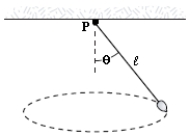
A)m2 gl3 sin4 /cos
B)m2 gl3 sin3 /cos
C)m2 gl3 sin2 /cos
D)m2 gl3 sin /cos
E)m2 gl3 sin2

A)m2 gl3 sin4 /cos
B)m2 gl3 sin3 /cos
C)m2 gl3 sin2 /cos
D)m2 gl3 sin /cos
E)m2 gl3 sin2

Unlock Deck
Unlock for access to all 48 flashcards in this deck.
Unlock Deck
k this deck
8
A massless rope is wrapped around a uniform cylinder that has radius R and mass M, as shown in the figure. Initially, the unwrapped portion of the rope is vertical and the cylinder is horizontal. The linear acceleration of the cylinder is: 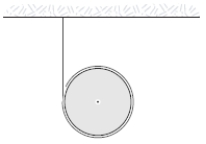
A)(2/3)g
B)(1/2)g
C)(1/3)g
D)(1/6)g
E)(5/6)g

A)(2/3)g
B)(1/2)g
C)(1/3)g
D)(1/6)g
E)(5/6)g

Unlock Deck
Unlock for access to all 48 flashcards in this deck.
Unlock Deck
k this deck
9
The rigid object shown is rotated about an axis perpendicular to the paper and through point P. The total kinetic energy of the object as it rotates is equal to 1.4 J. If M = 1.3 kg and L = 0.50 m, what is the angular velocity of the object? Neglect the mass of the connecting rods and treat the masses as particles. 
A)1.3 rad/s
B)1.5 rad/s
C)1.7 rad/s
D)1.2 rad/s
E)2.1 rad/s

A)1.3 rad/s
B)1.5 rad/s
C)1.7 rad/s
D)1.2 rad/s
E)2.1 rad/s

Unlock Deck
Unlock for access to all 48 flashcards in this deck.
Unlock Deck
k this deck
10
The rigid body shown rotates about an axis through its centre of mass and perpendicular to the paper. If M = 2.0 kg and L = 80 cm, what is the kinetic energy of this object when its angular speed about this axis is equal to 5.0 rad/s? Neglect the mass of the connecting rod and treat the masses as particles. 
A)18 J
B)15 J
C)12 J
D)23 J
E)26 J

A)18 J
B)15 J
C)12 J
D)23 J
E)26 J

Unlock Deck
Unlock for access to all 48 flashcards in this deck.
Unlock Deck
k this deck
11
During a race on the Gold Coast, a car of mass 1000 kg moves with a speed of 50 m/s on a circular track of radius 100 m. What is the magnitude of its angular momentum (in kg.m2/s) relative to the centre of the racetrack?
A)5.0 * 102
B)5.0 * 106
C)2.5 * 104
D)2.5 *106
E)5.0* 103
A)5.0 * 102
B)5.0 * 106
C)2.5 * 104
D)2.5 *106
E)5.0* 103

Unlock Deck
Unlock for access to all 48 flashcards in this deck.
Unlock Deck
k this deck
12
A particle whose mass is 2.0 kg moves in the xy plane with a constant speed of 3.0 m/s along the direction  . What is its angular momentum (in kg.m2/s) relative to the point (0, 5.0) metres?
. What is its angular momentum (in kg.m2/s) relative to the point (0, 5.0) metres?
A)12
B)11
C)13
D)14
E)21
 . What is its angular momentum (in kg.m2/s) relative to the point (0, 5.0) metres?
. What is its angular momentum (in kg.m2/s) relative to the point (0, 5.0) metres?A)12

B)11

C)13

D)14

E)21


Unlock Deck
Unlock for access to all 48 flashcards in this deck.
Unlock Deck
k this deck
13
In the figure shown, a 1.6-kg weight swings in a vertical circle at the end of a string having negligible weight. The string is 2-m long. If the weight is released with zero initial velocity from a horizontal position, its angular momentum (in kg.m2/s) at the lowest point of its path relative to the centre of the circle is approximately: 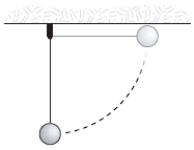
A)40
B)10
C)30
D)20
E)50

A)40
B)10
C)30
D)20
E)50

Unlock Deck
Unlock for access to all 48 flashcards in this deck.
Unlock Deck
k this deck
14
A puck on a frictionless air hockey table has a mass of 5.0 g and is attached to a cord passing through a hole in the surface as in the figure. The puck is revolving at a distance 2.0 m from the hole with an angular velocity of 3.0 rad/s. The cord is then pulled from below, shortening the radius to 1.0 m. The new angular velocity (in rad/s) is: 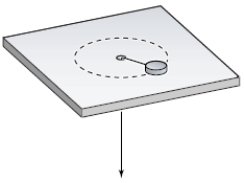
A)4.0
B)6.0
C)12
D)2.0
E)8.0

A)4.0
B)6.0
C)12
D)2.0
E)8.0

Unlock Deck
Unlock for access to all 48 flashcards in this deck.
Unlock Deck
k this deck
15
A particle whose mass is 2 kg moves in the xy plane with a constant speed of 3 m/s in the x direction along the line y = 5. What is its angular momentum (in kg.m2/s) relative to the origin?
A)(-30 )
)
B)30 11efb60d_b6b8_3442_8519_6b6fd13af782_TB8845_00
C)(-15 11efb60d_b6b8_3442_8519_6b6fd13af782_TB8845_00)
D)15 11efb60d_b6b8_3442_8519_6b6fd13af782_TB8845_00
E)45 11efb60d_b6b8_3442_8519_6b6fd13af782_TB8845_00
A)(-30
 )
)B)30 11efb60d_b6b8_3442_8519_6b6fd13af782_TB8845_00
C)(-15 11efb60d_b6b8_3442_8519_6b6fd13af782_TB8845_00)
D)15 11efb60d_b6b8_3442_8519_6b6fd13af782_TB8845_00
E)45 11efb60d_b6b8_3442_8519_6b6fd13af782_TB8845_00

Unlock Deck
Unlock for access to all 48 flashcards in this deck.
Unlock Deck
k this deck
16
A particle whose mass is 2 kg moves in the xy plane with a constant speed of 3 m/s along the direction  . What is its angular momentum (in kg.m2/s) relative to the origin?
. What is its angular momentum (in kg.m2/s) relative to the origin?
A)0
B)
C)
D)6
E)(-6 )
)
 . What is its angular momentum (in kg.m2/s) relative to the origin?
. What is its angular momentum (in kg.m2/s) relative to the origin?A)0

B)
C)

D)6

E)(-6
 )
)
Unlock Deck
Unlock for access to all 48 flashcards in this deck.
Unlock Deck
k this deck
17
A non-uniform 2.0-kg rod is 2.0 m long. The rod is mounted to rotate freely about a horizontal axis perpendicular to the rod that passes through one end of the rod. The moment of inertia of the rod about this axis is 4.0 kg.m2. The centre of mass of the rod is 1.2 m from the axis. If the rod is released from rest in the horizontal position, what is its angular speed as it swings through the vertical position?
A)3.4 rad/s
B)4.4 rad/s
C)4.3 rad/s
D)5.8 rad/s
E)6.8 rad/s
A)3.4 rad/s
B)4.4 rad/s
C)4.3 rad/s
D)5.8 rad/s
E)6.8 rad/s

Unlock Deck
Unlock for access to all 48 flashcards in this deck.
Unlock Deck
k this deck
18
Two cylinders made of the same material roll down a plane inclined at an angle with the horizontal. Each travels the same distance. The radius of cylinder B is twice the radius of cylinder A. In what order do they reach the bottom?
A)A reaches the bottom first because it has the greater acceleration.
B)A reaches the bottom first because it has a smaller moment of inertia.
C)B reaches the bottom first because is experiences a larger torque.
D)B reaches the bottom first because it travels a larger distance in one rotation.
E)They both reach the bottom at the same time, because each has the same linear acceleration.
A)A reaches the bottom first because it has the greater acceleration.
B)A reaches the bottom first because it has a smaller moment of inertia.
C)B reaches the bottom first because is experiences a larger torque.
D)B reaches the bottom first because it travels a larger distance in one rotation.
E)They both reach the bottom at the same time, because each has the same linear acceleration.

Unlock Deck
Unlock for access to all 48 flashcards in this deck.
Unlock Deck
k this deck
19
A puck on a frictionless air hockey table has a mass of 5.0 kg and is attached to a cord passing through a hole in the surface as in the figure. The puck is revolving at a distance 2.0 m from the hole with an angular velocity of 3.0 rad/s. The angular momentum of the puck (in kg.m2/s) is: 
A)80
B)20
C)30
D)60
E)50

A)80
B)20
C)30
D)60
E)50

Unlock Deck
Unlock for access to all 48 flashcards in this deck.
Unlock Deck
k this deck
20
A solid sphere, a solid cylinder, a spherical shell, and a hoop all have the same mass and radius. Each are rolling on a horizontal surface with the same centre of mass speed, and then they roll up identical inclines. Which one goes the greatest distance up its incline?
A)the hoop
B)the solid sphere
C)the spherical shell
D)the cylinder
E)They all go the same distance up their inclines.
A)the hoop
B)the solid sphere
C)the spherical shell
D)the cylinder
E)They all go the same distance up their inclines.

Unlock Deck
Unlock for access to all 48 flashcards in this deck.
Unlock Deck
k this deck
21
A force is applied to a cylindrical roll of paper of radius R and mass M by pulling on the paper as shown. The acceleration of the centre of mass of the roll of paper (when it rolls without slipping) is: 
A) .
B) .
C) .
D) .
E) .

A) .
B) .
C) .
D) .
E) .

Unlock Deck
Unlock for access to all 48 flashcards in this deck.
Unlock Deck
k this deck
22
A hockey puck travelling at speed v on essentially frictionless ice collides elastically with one end of a straight stick lying flat on the ice. In this collision:
A)momentum is conserved.
B)angular momentum is conserved.
C)energy is conserved.
D)all of the above are conserved.
E)only momentum and angular momentum are conserved.
A)momentum is conserved.
B)angular momentum is conserved.
C)energy is conserved.
D)all of the above are conserved.
E)only momentum and angular momentum are conserved.

Unlock Deck
Unlock for access to all 48 flashcards in this deck.
Unlock Deck
k this deck
23
Stars originate as large bodies of slowly rotating gas. Because of gravity, these clumps of gas slowly decrease in size. The angular velocity of a star increases as it shrinks because of:
A)conservation of angular momentum
B)conservation of linear momentum
C)conservation of energy
D)the law of universal gravitation
E)conservation of mass
A)conservation of angular momentum
B)conservation of linear momentum
C)conservation of energy
D)the law of universal gravitation
E)conservation of mass

Unlock Deck
Unlock for access to all 48 flashcards in this deck.
Unlock Deck
k this deck
24
The diagram below shows five cylinders, each cylinder rotating with constant angular velocity about its central axis. The magnitude of the tangential speed of one point of each cylinder is shown, along with each cylinder's radius and mass. Which cylinder has the largest angular momentum?
A)
B)
C)
D)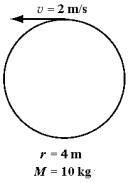
E)
A)

B)

C)

D)

E)


Unlock Deck
Unlock for access to all 48 flashcards in this deck.
Unlock Deck
k this deck
25
The diagram below shows five 20-kg rods of the same 2.0-m length free to rotate about axes through the rods, as indicated. Which rod experiences the greatest magnitude gravitational torque?
A)
B)
C)
D)
E)
A)

B)

C)

D)

E)


Unlock Deck
Unlock for access to all 48 flashcards in this deck.
Unlock Deck
k this deck
26
A hockey puck travelling at speed v on essentially frictionless ice collides with one end of a straight stick lying flat on the ice and sticks to that end. In this collision:
A)momentum is conserved.
B)angular momentum is conserved.
C)energy is conserved.
D)all of the above are conserved.
E)only momentum and angular momentum are conserved.
A)momentum is conserved.
B)angular momentum is conserved.
C)energy is conserved.
D)all of the above are conserved.
E)only momentum and angular momentum are conserved.

Unlock Deck
Unlock for access to all 48 flashcards in this deck.
Unlock Deck
k this deck
27
A 0.5 kg fish, hooked as shown below, starts to swim away at a speed of 3 m/s. The angular momentum of the fish relative to the hand holding the fishing rod is about: 
A) .
B) .
C) .
D) .
E) .

A) .
B) .
C) .
D) .
E) .

Unlock Deck
Unlock for access to all 48 flashcards in this deck.
Unlock Deck
k this deck
28
A space station out beyond the solar system is rotating with constant angular velocity. A spaceship heading into the station along a diameter of the station, uses its rockets to brake, and then docks inside the station at its centre. When the spaceship docks, the angular momentum of the system consisting of the station and ship:
A)is less than the original angular momentum of the station.
B)is the same as the original angular momentum of the station.
C)is greater than the original angular momentum of the station.
D)is less than the original angular momentum of the station, but the angular velocity increases.
E)is greater than the original angular momentum of the station, but the angular velocity decreases.
A)is less than the original angular momentum of the station.
B)is the same as the original angular momentum of the station.
C)is greater than the original angular momentum of the station.
D)is less than the original angular momentum of the station, but the angular velocity increases.
E)is greater than the original angular momentum of the station, but the angular velocity decreases.

Unlock Deck
Unlock for access to all 48 flashcards in this deck.
Unlock Deck
k this deck
29
Five objects of mass m move at velocity  at a distance r from an axis of rotation perpendicular to the page through point A, as shown below. The one that has zero angular momentum about that axis is:
at a distance r from an axis of rotation perpendicular to the page through point A, as shown below. The one that has zero angular momentum about that axis is:
A)
B)
C)
D)
E)
 at a distance r from an axis of rotation perpendicular to the page through point A, as shown below. The one that has zero angular momentum about that axis is:
at a distance r from an axis of rotation perpendicular to the page through point A, as shown below. The one that has zero angular momentum about that axis is:A)

B)

C)

D)

E)


Unlock Deck
Unlock for access to all 48 flashcards in this deck.
Unlock Deck
k this deck
30
A torque can be exerted on a body with a fixed axis of rotation:
A)only by a centripetal force.
B)only by a force directed radially outwards.
C)only by a tangential force.
D)only by a force with a component directed radially outwards.
E)by any force not pointing directly toward or away from the axis of rotation.
A)only by a centripetal force.
B)only by a force directed radially outwards.
C)only by a tangential force.
D)only by a force with a component directed radially outwards.
E)by any force not pointing directly toward or away from the axis of rotation.

Unlock Deck
Unlock for access to all 48 flashcards in this deck.
Unlock Deck
k this deck
31
A solid sphere, spherical shell, solid cylinder and a cylindrical shell all have the same mass m and radius R. If they are all released from rest at the same elevation and roll without slipping, which reaches the bottom of an inclined plane first?
A)solid sphere
B)spherical shell
C)solid cylinder
D)cylindrical shell
E)all take the same time
A)solid sphere
B)spherical shell
C)solid cylinder
D)cylindrical shell
E)all take the same time

Unlock Deck
Unlock for access to all 48 flashcards in this deck.
Unlock Deck
k this deck
32
Refer to Exhibit 10-1 below.Exhibit 10-1 Two blocks of masses m1 and m2 are connected by a light cord that passes over a pulley of mass M, as shown. Block m2 slides on a frictionless horizontal surface. The blocks and pulley are initially at rest. When m1 is released, the blocks accelerate and the pulley rotates. 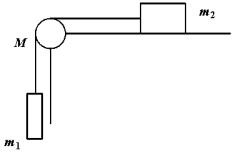 The total angular momentum of the system of the two blocks and the pulley relative to the axis of rotation of the pulley is:
The total angular momentum of the system of the two blocks and the pulley relative to the axis of rotation of the pulley is:
A)the same at all times.
B)proportional to l1, the length of string from the pulley to m1.
C)proportional to l2, the length of string from the pulley to m2.
D)conserved because the Earth doesn't move.
E)proportional to the speed of the blocks.
 The total angular momentum of the system of the two blocks and the pulley relative to the axis of rotation of the pulley is:
The total angular momentum of the system of the two blocks and the pulley relative to the axis of rotation of the pulley is:A)the same at all times.
B)proportional to l1, the length of string from the pulley to m1.
C)proportional to l2, the length of string from the pulley to m2.
D)conserved because the Earth doesn't move.
E)proportional to the speed of the blocks.

Unlock Deck
Unlock for access to all 48 flashcards in this deck.
Unlock Deck
k this deck
33
A skater extends her arms horizontally, holding a 5-kg mass in each hand. She is rotating about a vertical axis with an angular velocity of one revolution per second. If she drops her hands to her sides, what will the final angular velocity (in rev/s) be if her moment of inertia remains approximately constant at 5 kg.m2, and the distance of the masses from the axis changes from 1 m to 0.1 m?
A)6
B)3
C)9
D)4
E)7
A)6
B)3
C)9
D)4
E)7

Unlock Deck
Unlock for access to all 48 flashcards in this deck.
Unlock Deck
k this deck
34
A top is set spinning so that the rotation is counterclockwise around its axis when viewed from above. When the top is placed on a level surface it happens that its axis of rotation is not quite vertical. Viewed from above, which way does the rotational axis of the top precess?
A)clockwise
B)counterclockwise
C)It's random, if it starts clockwise it will continue clockwise, and vice versa, i.e., a 50% chance either way.
D)The direction depends on the little shove given to the axis when the top is placed on the surface.
E)In the northern hemisphere it will be clockwise, in the southern hemisphere it will be counterclockwise.
A)clockwise
B)counterclockwise
C)It's random, if it starts clockwise it will continue clockwise, and vice versa, i.e., a 50% chance either way.
D)The direction depends on the little shove given to the axis when the top is placed on the surface.
E)In the northern hemisphere it will be clockwise, in the southern hemisphere it will be counterclockwise.

Unlock Deck
Unlock for access to all 48 flashcards in this deck.
Unlock Deck
k this deck
35
When an object is effectively isolated from external torques, such as an ice skater twirling on the tip of one skate, the angular momentum of the object:
A)can be increased by shifting mass out away from the axis of rotation.
B)can be decreased by shifting mass out away from the axis of rotation.
C)can be increased by shifting mass in toward the axis of rotation.
D)can be decreased by shifting mass in toward the axis of rotation.
E)cannot be changed except by friction at the point of contact.
A)can be increased by shifting mass out away from the axis of rotation.
B)can be decreased by shifting mass out away from the axis of rotation.
C)can be increased by shifting mass in toward the axis of rotation.
D)can be decreased by shifting mass in toward the axis of rotation.
E)cannot be changed except by friction at the point of contact.

Unlock Deck
Unlock for access to all 48 flashcards in this deck.
Unlock Deck
k this deck
36
The object shown below has mass m and velocity  . The direction of its angular momentum vector with respect to an axis perpendicular to the page through point O is:
. The direction of its angular momentum vector with respect to an axis perpendicular to the page through point O is: 
A)downwards.
B)to the right.
C)into the page.
D)up out of the page.
E)counterclockwise.
 . The direction of its angular momentum vector with respect to an axis perpendicular to the page through point O is:
. The direction of its angular momentum vector with respect to an axis perpendicular to the page through point O is: 
A)downwards.
B)to the right.
C)into the page.
D)up out of the page.
E)counterclockwise.

Unlock Deck
Unlock for access to all 48 flashcards in this deck.
Unlock Deck
k this deck
37
Two objects of mass m1 = 2m and m2 = m move around a rotation axis A in parallel circles of radii r1 = r and r2 = 2r with equal tangential speeds. As they rotate, forces of equal magnitude are applied opposite to their velocities to stop them. Which statement is correct? 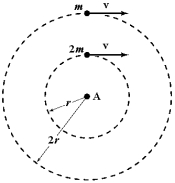
A)m2 will stop first because it has the larger initial angular velocity.
B)m1 will stop first because it has the smaller radius.
C)m2 will stop first because the torque on it is greater.
D)m1 will stop first because it has the smaller moment of inertia.
E)Both objects will stop at the same time because the angular accelerations are equal.

A)m2 will stop first because it has the larger initial angular velocity.
B)m1 will stop first because it has the smaller radius.
C)m2 will stop first because the torque on it is greater.
D)m1 will stop first because it has the smaller moment of inertia.
E)Both objects will stop at the same time because the angular accelerations are equal.

Unlock Deck
Unlock for access to all 48 flashcards in this deck.
Unlock Deck
k this deck
38
A cylindrical shell rolls without slipping down an incline as shown in the figure. The linear acceleration of its centre of mass is: 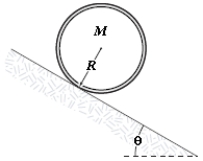
A)(5/7)g sin
B)(1/2)g sin
C)(3/5)g sin
D)(2/3)g sin
E)(4/5)g sin

A)(5/7)g sin
B)(1/2)g sin
C)(3/5)g sin
D)(2/3)g sin
E)(4/5)g sin

Unlock Deck
Unlock for access to all 48 flashcards in this deck.
Unlock Deck
k this deck
39
Five identical cylinders are each acted on by forces of equal magnitude. Which force exerts the biggest torque about the central axes of the cylinders?
A)
B)
C)
D)
E)
A)

B)

C)

D)

E)


Unlock Deck
Unlock for access to all 48 flashcards in this deck.
Unlock Deck
k this deck
40
A solid sphere (radius R, mass M) rolls without slipping down an incline as shown in the figure. The linear acceleration of its centre of mass is: 
A)(5/7)g sin
B)(3/5)g sin
C)(2/3)g sin
D)(1/2)g sin
E)(4/5)g sin

A)(5/7)g sin
B)(3/5)g sin
C)(2/3)g sin
D)(1/2)g sin
E)(4/5)g sin

Unlock Deck
Unlock for access to all 48 flashcards in this deck.
Unlock Deck
k this deck
41
If L represents angular momentum, I represents moment of inertia, p represents linear momentum, m represents mass, and r represents a distance, which of the following can represent kinetic energy?
A)p2/2m
B)L2/2I
C)rpI
D)all of the above
E)both (a) and (b)
A)p2/2m
B)L2/2I
C)rpI
D)all of the above
E)both (a) and (b)

Unlock Deck
Unlock for access to all 48 flashcards in this deck.
Unlock Deck
k this deck
42
A 3.0-kg particle has a position vector given by where is in metres and t is in seconds. What is the angular momentum of the particle, in kg.m2/s, about the origin at t = 2 s?
A)72
B)(-72 )
)
C)24
D)(-24 )
)
E)22
A)72

B)(-72
 )
)C)24

D)(-24
 )
)E)22


Unlock Deck
Unlock for access to all 48 flashcards in this deck.
Unlock Deck
k this deck
43
A uniform solid sphere rolls without slipping along a horizontal surface. What fraction of its total kinetic energy is in the form of rotational kinetic energy about the CM?

Unlock Deck
Unlock for access to all 48 flashcards in this deck.
Unlock Deck
k this deck
44
The net work done in accelerating a propeller from rest to an angular velocity of 200 rad/s is 3000 J. What is the moment of inertia of the propeller?

Unlock Deck
Unlock for access to all 48 flashcards in this deck.
Unlock Deck
k this deck
45
Halley's comet moves about the sun in an elliptical orbit with its closest approach to the sun being 0.59 A.U. and its furthest distance being 35 A.U. [1 Astronomical Unit (A.U.) is the Earth-sun distance.] If the comet's speed at closest approach is 54 km/s, what is its speed when it is farthest from the sun?

Unlock Deck
Unlock for access to all 48 flashcards in this deck.
Unlock Deck
k this deck
46
A regulation basketball has a 25.0-cm diameter and a mass of 0.560 kg. It may be approximated as a thin spherical shell with a moment of inertia MR2. Starting from rest, how long will it take a basketball to roll without slipping 4.00 m down an incline at 30.0 to the horizontal?

Unlock Deck
Unlock for access to all 48 flashcards in this deck.
Unlock Deck
k this deck
47
A coin with a diameter 3.00 cm rolls up a 30.0 inclined plane. The coin starts out with an initial angular speed of 60.0 rad/s and rolls in a straight line without slipping. If the moment of inertia of the coin is MR2, how far will the coin roll up the inclined plane?

Unlock Deck
Unlock for access to all 48 flashcards in this deck.
Unlock Deck
k this deck
48
What is the angular momentum of the moon about the Earth? The mass of the moon is 7.35 * 1022 kg, the centre-to-centre separation of the Earth and the moon is 3.84 * 105 km, and the orbital period of the moon is 27.3 days. Ignore the small offset of the centre of mass of the system from the centre of the Earth in your calculation.

Unlock Deck
Unlock for access to all 48 flashcards in this deck.
Unlock Deck
k this deck



